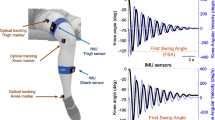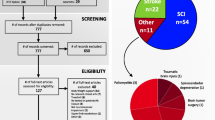Abstract
An important methodological challenge in multi-segment kinetic foot models is to partition the total ground reaction force across different foot segments. Several studies applied a proportionality scheme based on the combination of a pressure- and force platform. A recent study highlighted distinct errors in the partitioning of shear forces when using this proportionality scheme. To date, the impact of this shear force partitioning error analysis on joint moment calculations using inverse dynamic calculations in pathological gait is not known. Hence, the goal of this study was to investigate the clinical applicability of an existing proportionality scheme by extending the shear force partitioning error analysis towards joint moment calculations. Both healthy (n = 10) and pathological gait (n = 10) was assessed using (I) an adjacent force plate method and (II) the estimation method based on an existing proportionality scheme. A correction factor matrix was developed to compensate for the shear force partitioning errors in the estimation method. Extending the shear force partitioning error analysis towards joint moments using inverse dynamic calculations, did not reveal significant differences when comparing corrected joint moments with the estimated joint moments in both healthy and pathological gait.





Similar content being viewed by others
Change history
27 September 2019
This article was updated to correct Giovanni A. Matricali’s name.
References
Bruening, D. A., K. M. Cooney, and F. L. Buczek. Analysis of a kinetic multi-segment foot model part II: kinetics and clinical implications. Gait Posture 35:535–540, 2012.
Bruening, D. A., K. M. Cooney, F. L. Buczek, and J. G. Richards. Measured and estimated ground reaction forces for multi-segment foot models. J. Biomech. 43:3222–3226, 2010.
Deschamps, K., M. Eerdekens, D. Desmet, G. A. Matricali, S. Wuite, and F. Staes. Estimation of foot joint kinetics in three and four segment foot models using an existing proportionality scheme: application in paediatric barefoot walking. J. Biomech. 61:168–175, 2017.
Deschamps, K., F. Staes, H. Bruyninckx, E. Busschots, E. Jaspers, A. Atre, and K. Desloovere. Repeatability in the assessment of multi-segment foot kinematics. Gait Posture 35:255–260, 2012.
Deschamps, K., F. Staes, H. Bruyninckx, E. Busschots, G. A. Matricali, P. Spaepen, C. Meyer, and K. Desloovere. Repeatability of a 3D multi-segment foot model protocol in presence of foot deformities. Gait Posture 36:635–638, 2012.
Giacomozzi, C., and V. Macellari. Piezo-dynamometric platform for a more complete analysis of foot-to- floor interaction. IEEE Trans. Rehabil. Eng. 5:322–330, 1997.
Grabiner, M. D., J. W. Feuerbach, T. M. Lundin, and B. L. Davis. Visual guidance to force plates does not influence ground reaction force variability. J. Biomech. 1995. https://doi.org/10.1016/0021-9290(94)00175-4.
Hanavan, E. P. A mathematical model of the human body. AMRL-TR-64-102. Aerospace 1–149, 1964.
Leardini, A., M. G. Benedetti, L. Berti, D. Bettinelli, R. Nativo, and S. Giannini. Rear-foot, mid-foot and fore-foot motion during the stance phase of gait. Gait Posture 25:453–462, 2007.
MacWilliams, B. A., M. Cowley, and D. E. Nicholson. Foot kinematics and kinetics during adolescent gait. Gait Posture 17:214–224, 2003.
Nüesch, C., V. Valderrabano, C. Huber, V. Von Tscharner, and G. Pagenstert. Gait patterns of asymmetric ankle osteoarthritis patients. Clin. Biomech. 27:613–618, 2012.
Orendurff, M. S., T. Kobayashi, K. Tulchin-Francis, A. M. H. Tullock, C. Villarosa, C. Chan, and S. Strike. A little bit faster: lower extremity joint kinematics and kinetics as recreational runners achieve faster speeds. J. Biomech. 71:167–175, 2018.
Pataky, T. C. One-dimensional statistical parametric mapping in Python. Comput. Methods Biomech. Biomed. Eng. 15:295–301, 2012.
Sangeorzan, A., and B. Sangeorzan. Subtalar joint biomechanics: from normal to pathologic. Foot Ankle Clin 2018. https://doi.org/10.1016/j.fcl.2018.04.002.
Saraswat, P., B. A. MacWilliams, R. B. Davis, and J. L. D’Astous. Kinematics and kinetics of normal and planovalgus feet during walking. Gait Posture 39:339–345, 2014.
Valderrabano, V., B. M. Nigg, V. von Tscharner, D. J. Stefanyshyn, B. Goepfert, and B. Hintermann. Gait analysis in ankle osteoarthritis and total ankle replacement. Clin. Biomech. 22:894–904, 2007.
Wearing, S. C., S. R. Urry, and J. E. Smeathers. Ground reaction forces at discrete sites of the foot derived from pressure plate measurements. Foot Ankle Int. 2001. https://doi.org/10.1177/107110070102200807.
Wilken, J. M., K. M. Rodriguez, M. Brawner, and B. J. Darter. Reliability and minimal detectible change values for gait kinematics and kinetics in healthy adults. Gait Posture 35:301–307, 2012.
Acknowledgments
This study was supported by the ASPIRE 2015 (Pfizer) research grant and the Novo Nordisk Clinical Research Grant (KD). Sponsors had no involvement in this article.
Author information
Authors and Affiliations
Corresponding author
Additional information
Associate Editor Michael S. Detamore oversaw the review of this article.
Publisher's Note
Springer Nature remains neutral with regard to jurisdictional claims in published maps and institutional affiliations.
This article was updated to correct Giovanni A. Matricali’s name.
Electronic supplementary material
Below is the link to the electronic supplementary material.
Rights and permissions
About this article
Cite this article
Eerdekens, M., Staes, F., Matricali, G.A. et al. Clinical Applicability of an Existing Proportionality Scheme in Three-Segment Kinetic Foot Models. Ann Biomed Eng 48, 247–257 (2020). https://doi.org/10.1007/s10439-019-02344-8
Received:
Accepted:
Published:
Issue Date:
DOI: https://doi.org/10.1007/s10439-019-02344-8




